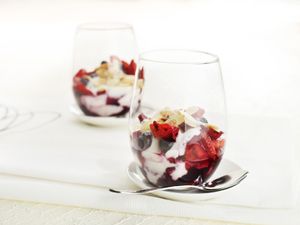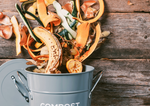Make your own: yoghurt
by Anne Finch, Accredited Practising Dietitian for LiveLighter
- April 28, 2017
- Leave a comment

Looking for a fun new project? Want to know exactly what's in your food? Welcome to the MYO series, where we look at how to prepare some of your favourite foods from scratch. We were inspired to try making our own yoghurt after investigating the yoghurts on the supermarket shelves. Check out the results here! [link]
Making your own yoghurt is fun and super easy (despite the long instructions). You basically:
- Heat milk
- Stir in some shop-bought yoghurt
- Wait a few hours for the cultures to do their thing
You could be eating your own yoghurt for breakfast!
Equipment needed
- Large pot (Dutch oven or other heavy pot that retains heat is a good idea)
- Measuring cup
- Small bowl
- Fork or whisk
- Cooking thermometer (optional)
- Somewhere to keep your yoghurt warm eg. oven, esky, crockpot/ slow-cooker, thermos, dehydrator or Thermomix
- Jars or other container to keep your yoghurt in
Ingredients
- 2 L reduced-fat milk (not skim)
- ½ cup plain yoghurt (choose one that says “live cultures” and doesn’t have any emulsifiers or thickeners on the ingredients list)
Note: this makes 2 L (about 2 kg) of yoghurt. Use 1 L of milk and 1/4 cup of yoghurt to make a smaller batch
What to do
- Wash your hands well and make sure all of your equipment is very clean or you could introduce unpleasant bacteria that will spoil your yoghurt! Carefully pour boiling water over the equipment that will come into contact with the yoghurt and let it air dry or dry with a paper towel.
- Heat the milk on a low heat until almost boiling (about 94°C if you have a thermometer). Stir it every now and again to stop the milk catching on the bottom of the pan and burning. The milk will simmer and foam up – don’t worry! The milk needs to get very hot to change the structure of the proteins so that it will set properly. If you’re not sure if it’s nearly boiling yet, leave it a bit longer.
- Take the milk off the heat and leave to cool to about 45°C. This is hot shower temperature. There should be no steam coming off the milk and you should be able to comfortably hold your finger in the milk without it feeling too hot. While waiting for it to cool, stir it occasionally to stop a skin from forming on the top. If a skin does form, you can stir it back in or remove (and eat!) it. If you want to speed up the cooling, put the saucepan in an ice-bath, stir it and/or pour it from one vessel to another.
- Whisk a little of the warm milk into the bowl of shop-bought yoghurt to thin it out. Then pour this mixture into the saucepan of warm milk and mix well.
- Now you want to find a cosy place to keep the milk at for at least 4 hours (or overnight) so that the cultures can multiply. They like to do this at about 43°C.
- If you’ve used a heavy pot that will retain its heat for a while, you can wrap it in towels and put the whole thing in the oven (turned off or with just the light on to create a little heat).
- If you’re using a thermos or crock pot, heat it up by pouring hot water inside, swishing it around, and then pouring it out. Then put the warm milk in and wrap with towels to help keep the heat in.
- To do this in a small esky, pour the yoghurt into jars or other small containers with lids. Put the jars in the esky, then fill halfway up the jars with water that’s about 50°C (hint: in most houses, the hot water from the tap gets to a maximum of 60°C).
- If you have a dehydrator or a Thermomix set it for 43°C.
- Wait for the yoghurt to set. This will take at least 4 hours but will depend on the cultures in the yoghurt and the temperature that it’s sitting at. The longer you let it sit, the thicker and more zingy it will be. Don’t stir or shake it while it’s doing its thing.
- Cool in the fridge (either in the big container it’s in or in smaller containers like jars). It’ll thicken up a bit more once it’s cold. If there is some watery whey on top, you can either drain it off or whisk it back into the yoghurt.
- Enjoy! It will keep for 1-2 weeks in the fridge.
We’d love to hear how you go making your own yoghurt!
Frequently asked questions
Isn’t it dangerous to leave warm milk out? Won’t it go off?
The cultures (bacteria) in the yoghurt prevent the milk from going bad – for a time at least! The yoghurt cultures reproduce and muscle out bad bacteria who might like to grow in the milk. Yoghurt cultures also produce acids which lower the pH. This makes it a good environment for yoghurt cultures to grow, and hard for many of the bad bacteria to grow. As soon as your yoghurt is set, store it in the fridge. This will make it last longer.
Can I use my home-made yoghurt to start my next batch of yoghurt?
Yes! It’s best to do this when the yoghurt is still quite “young” – within a week. Older home-made yoghurt might not have enough live cultures left to start your new yoghurt. After doing this cycle a few times, you might need to “refresh” your culture by adding in some new shop-bought yoghurt. If your yoghurt doesn’t thicken up or starts to smell or taste unpleasant, it’s probably time for a refresh.
Can I make flavoured yoghurt?
Yes, but add flavourings just before serving. Adding them before culturing will mess with the culture’s environment and you might not get a nice result. Try fresh, frozen or canned fruit, cinnamon, vanilla or a little jam or honey. You could even try cucumber and mint for a savoury twist!
What can I do with the whey?
If you like a thicker yoghurt, you can pour the whey off the top once the yoghurt has cooled. To get it even thicker you can strain it through a cheesecloth or a clean Chux. That whey can then be used in place of milk or water in recipes like smoothies, pancakes, pizza dough, stock or soup. Or you can just drink it straight. It tastes quite mild and a little sour and has some protein and very little fat or sugar.







